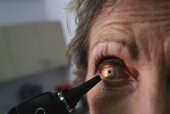- Skip Storing This Everyday Product in the Fridge Door
- Green Tea + B3 Pairing May Boost Brain Health
- Navigating Your Midlife Crisis: Embracing New Possibilities
- City Raccoons Showing Signs of Domestication
- Mapping the Exposome: Science Broadens Focus to Environmental Disease Triggers
- One Week Less on Social Media Linked to Better Mental Health
- Your Brain Changes in Stages as You Age, Study Finds
- Some Suicide Victims Show No Typical Warning Signs, Study Finds
- ByHeart Formula Faces Lawsuits After Babies Sickened With Botulism
- Switch to Vegan Diet Could Cut Your Greenhouse Gas Emissions in Half
Postmenopausal Estrogen Therapy Tied to Lower Glaucoma Risk


Women who take estrogen-only hormone-replacement therapy to relieve menopausal symptoms might also be reducing their risk for a common form of the eye disease glaucoma, according to new research.
“Ours is one of the first … studies to find estrogen-containing hormone-replacement therapy was associated with a reduction in glaucoma risk,” said study researcher Dr. Joshua Stein, an assistant professor of ophthalmology at the University of Michigan.
Other studies, however, have come up with conflicting results, Stein said. In his study, he looked at insurance-claims data for women aged 50 and older who were enrolled in a managed care plan for at least four years. The women visited an eye care provider at least twice from 2001 to 2009.
He evaluated information on more than 152,000 women, about 60,000 of whom had at least one prescription for estrogen-only therapy, he said. The others took a combination of estrogen and progesterone or estrogen plus an androgen (male hormone).
During the study period, about 2 percent of the women developed a common form of glaucoma known as primary open angle glaucoma, Stein said, which develops when pressure builds up in the eye. Glaucoma refers to a group of eye diseases that damage the optic nerve and can lead to blindness. Treatment can help preserve vision.
Each month of estrogen use reduced the risk of glaucoma by 0.4 percent, and that risk reduction accumulated over time, Stein said. After four years of continuous use, the reduction in risk would be about 19 percent, he said.
Although the researchers found an association between the use of estrogen-only therapy and a reduced risk for this form of glaucoma, they did not prove a cause-and-effect link. No link was found for the other hormone regimens.
The study was published online Jan. 30 in the journal JAMA Ophthalmology.
Estrogen might work by lowering the pressure or by protecting certain cells in the eye, the researchers said.
Hormone-replacement therapy has been linked with increased health risks, such as heart disease, breast cancer and stroke. One 10-year follow-up of the Women’s Health Initiative estrogen-only trial, however, found a reversal of the health risks among women who’d had a hysterectomy.
The new study results do not suggest that reducing the risk of glaucoma is reason enough to take hormone replacement therapy, said Dr. Angela Turalba, a glaucoma specialist at the Massachusetts Eye and Ear Infirmary.
Rather, the findings may prompt drug companies to begin looking at estrogen as a glaucoma treatment, said Turalba, who reviewed the research. “The findings are most helpful in guiding research in drug development for hormone-based therapies to be used as neuro-protective agents,” she said.
Stein agreed. He said the goal would be to encourage drug companies to develop topical estrogen derivatives and study them as a glaucoma-preventive therapy.
The focus of the study was on women, he said, so there is no way to know whether estrogen-based treatments would also help men reduce glaucoma risk.
More information
To learn more about glaucoma, visit the Glaucoma Research Foundation.
Source: HealthDay
Copyright © 2025 HealthDay. All rights reserved.










